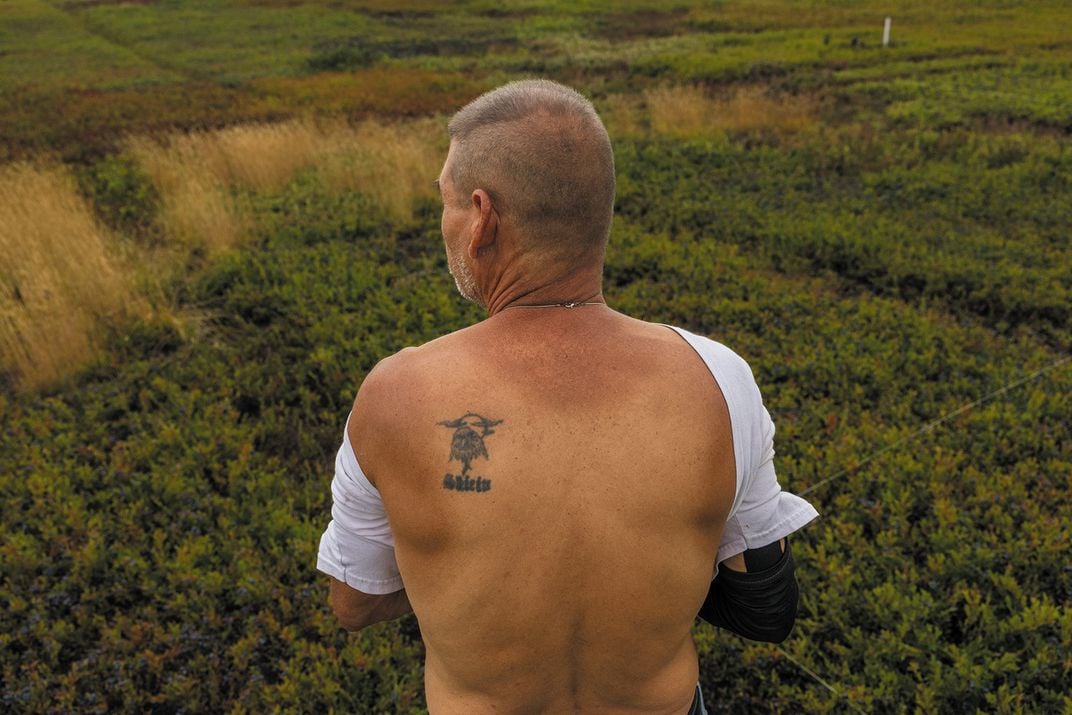Photographed by Greta Rybus
Written by Kate Olson
The Wild Blueberry Harvest in Maine
Bryan Johnson’s journey to the wild blueberry camps in rural Maine in 2023 marked a significant moment for him. As a Mi’kmaq fisherman from Nova Scotia, Canada, this annual tradition held a deep cultural significance. Growing up, Johnson heard stories of his parents and grandmother traveling to Maine each summer for the harvest, a mix of work, vacation, and a way to save money. After years of planning, he finally made the trip himself, uncertain of what to expect.
Arriving at the blueberry barrens, Johnson joined a diverse group of harvesters. From local native tribes to migrant farmworkers from Central America and the Caribbean, the blueberry fields truly brought people together from all walks of life. The unique wild blueberries harvested in these fields are smaller and sweeter than their commercial counterparts, packed with antioxidants and nutrition. For the Wabanaki peoples, including the Mi’kmaq, Maliseet, Passamaquoddy, Penobscot, and Abenaki, these berries have been a staple for centuries, used in various ways from food to medicine to dye.
Mi’kmaq language educator Giselle Stevens from Nova Scotia, Canada harvesting wild blueberries
The Significance of Wild Blueberries
The wild blueberry harvest in Maine goes beyond just a cultural tradition; it plays a vital role in the state’s economy and history. The Wabanaki tribes have nurtured the growth of wild blueberries for generations, sustaining the land and themselves in the process. However, modern challenges like climate change and market competition pose a threat to this longstanding practice. Commercial growers favor highbush blueberries, leading to a decline in the demand for wild blueberries, while environmental changes impact the natural habitat of these berries. Finding a balance between tradition and adaptation is crucial for the future of the wild blueberry harvest.
 Passamaquoddy tribal member Tomah with a tattoo saying “Skicin,” meaning “land dweller” in their language
Passamaquoddy tribal member Tomah with a tattoo saying “Skicin,” meaning “land dweller” in their language
The Changing Face of Harvesting
Over the years, the demographics of the wild blueberry harvest have shifted. While the Wabanaki tribes continue to be a significant part of the harvest, migrant workers from different parts of the world, particularly Mexico, Haiti, Honduras, and El Salvador, have also become integral to the process. These workers travel along the East Coast, following the growing seasons and contributing to various agricultural activities. Their participation highlights the evolving nature of the harvest, blending cultural traditions with modern-day agricultural practices.
 Andrew Syliboy and Newell Joseph Tomah working in the blueberry fields
Andrew Syliboy and Newell Joseph Tomah working in the blueberry fields
Preserving the Tradition of Maine’s Wild Blueberry Harvest
In the heart of Maine’s vibrant wild blueberry industry lies a fundamental workforce that often operates under the radar in a predominantly white state. Juana Rodriguez Vazquez, the executive director of Mano en Mano, emphasizes that the hardworking individuals picking the food in the fields are often overlooked and undervalued. April Norton of Wyman’s, a major wild blueberry producer in the state, highlights the critical role of the migrant and seasonal workforce in ensuring a successful harvest.
Exploring the blueberry barrens during the initial stages of the harvest is a captivating experience. The Passamaquoddy Wild Blueberry Company, owned and managed by the Passamaquoddy Tribe, diligently tends to 2,000 acres of blueberry fields. This land, part of ancestral territory taken in centuries past, was repurchased by the tribe in the 1980s through a congressional settlement, which remains a point of contention with Maine regarding various implementation aspects.
Nestled within the blueberry fields are camp cabins where harvesters and their families reside. These camps, maintained by the Passamaquoddy, foster a sense of community and camaraderie among the residents. Darren Paul, the company’s general manager, guided a firsthand rake selection experience in preparation for the labor-intensive harvest. Stephanie Bailey, a Passamaquoddy harvest supervisor, shares stories of historical struggles faced by their people, including the suppression of Indigenous cultures through government policies over the decades.
In an effort to rectify past injustices, Maine Governor Paul LePage, alongside chiefs from five Wabanaki tribes, established a groundbreaking Truth and Reconciliation Commission in 2013. This commission addressed issues such as the unjust separation of Wabanaki children from their families by the state’s child welfare system, shedding light on systemic injustices faced by Native communities.
As new harvesters like Johnson, a fisherman from Nova Scotia, join the labor force, they are introduced to the physical demands of the job, learning the intricate process of blueberry raking. Despite the arduous nature of the work, the sense of community and shared traditions at the blueberry camps create a welcoming environment for all involved. Johnson’s experience exemplifies the deep connection felt with the land and ancestors during the harvest season.
The preservation of Maine’s wild blueberry harvest tradition not only depends on the labor of dedicated workers but also on acknowledging and honoring the historical and cultural significance woven into the fabric of the industry. The colorful tapestry of stories, struggles, and resilience in Maine’s blueberry barrens encapsulates a profound narrative of perseverance and unity.
Deborah Thiebaux, a member of the Mi’kmaq tribe hailing from Nova Scotia, carries on the ancestral tradition of wild blueberry harvesting that spans across the Canadian border. This practice has endured for generations and remains a vital way of life for many. Thiebaux’s connection to the land runs deep, reflecting a sense of belonging and heritage that resonates with her as she continues this time-honored practice.
Harvesters like John Googoo, a crew supervisor, play a crucial role in the process, educating newcomers on the different raking styles of scooping and sweeping. The sweeping technique, a graceful, sweeping motion across the berries, showcases the skill of advanced rakers, while the scooping method requires a shorter, downwards movement to gently gather the berries without disturbing the plant. Typically, experienced pickers fill around 40 to 50 boxes a day, showcasing the dedication and hard work that goes into this labor-intensive process.
Bryan Johnson, a Mi’kmaq fisherman, experienced his first blueberry harvest last year, feeling a profound connection to his ancestors during this time. The sense of heritage and tradition is palpable in the fields as each harvester carries on the legacy of their forebears, embodying a deep-rooted sense of belonging and purpose.
The blueberry harvest faces a myriad of environmental challenges, from late frosts and extreme heat to drought conditions. Maine’s blueberry production has seen fluctuations over the years, with varying yields that highlight the unpredictable nature of agriculture. In 2000, the state produced around 110 million pounds of blueberries, while last year’s yield was closer to 85 million pounds, underscoring the impact of changing climatic conditions on crop output.
The Blueberry Harvest School in Milbridge serves as a vital support system for working families during the harvest season, providing a safe and enriching environment for children while their parents work in the fields. The school offers instruction in Spanish, English, and Mi’kmaq/Passamaquoddy languages, reflecting the diverse cultural tapestry of the community and fostering a sense of inclusivity and belonging among students.
As climate change continues to impact traditional harvest patterns, the blueberry season has shifted, with harvests starting earlier due to warming trends. Extreme weather events like late frosts and droughts pose significant challenges for growers, necessitating innovative solutions to mitigate the effects of climate change on crop yields. Scientists are studying how blueberries respond to environmental stressors, offering insights that can help farmers adapt to changing conditions and preserve this vital industry in Maine.
The blueberry barrens, spanning 46,000 acres, are a unique ecosystem that supports wild blueberry growth. Unlike planted bushes, wild berries act as groundcover, a practice encouraged by the Wabanaki people through prescribed burns. This sustainable approach to blueberry cultivation honors the land’s natural rhythms and fosters a harmonious relationship between humans and the environment.
After the harvest season comes to a close, the blueberry fields transition into a vibrant display of red hues as autumn sets in. The changing seasons mark the cyclical nature of life on the land, embodying a sense of renewal and transformation that mirrors the timeless tradition of wild blueberry harvesting.Bailey’s Connection to Community and Culture
As the cold winter wind blows and blankets the land with snow, Bailey shares her memories and experiences from the barrens of Indian Township. Reflecting on her childhood days spent picking berries with her grandmother, she speaks of the strong sense of community that once thrived in those lands. In a recent FaceTime conversation, Bailey reminisces about the importance of recreating that community and connecting with people in a similar way.
Creating Community Through Shared Resources and Meals
Bailey now runs a store at the blueberry camp, providing rakers with access to affordable food on credit. She actively organizes meals to ensure that everyone is fed, recognizing that not everyone may have the means to contribute financially. Her efforts to bring people together through shared resources and meals demonstrate her commitment to fostering a sense of community and support among her peers.
Preserving Cultural Traditions Through Generational Involvement
Despite a history of cultural suppression, Bailey is determined to preserve and celebrate her Native American heritage. She fondly recalls how she now brings her grandchildren to the harvest, where they participate in the Blueberry Harvest School during the day and enjoy the camp activities at night. By involving future generations in cultural traditions and community activities, Bailey emphasizes the dynamic and evolving nature of culture.
Looking Towards the Future of Community and Culture
Bailey’s story serves as a reminder that culture is not static but continuously evolves through the efforts of individuals like herself. By fostering a sense of community and preserving cultural traditions, she actively contributes to the resilience and vibrancy of her people. As she navigates the changing seasons and landscapes of Indian Township, Bailey remains dedicated to creating a lasting legacy of community and culture for generations to come.
—-
Author : usa-news
Publish date : 2024-06-30 07:43:51
Copyright for syndicated content belongs to the linked Source.